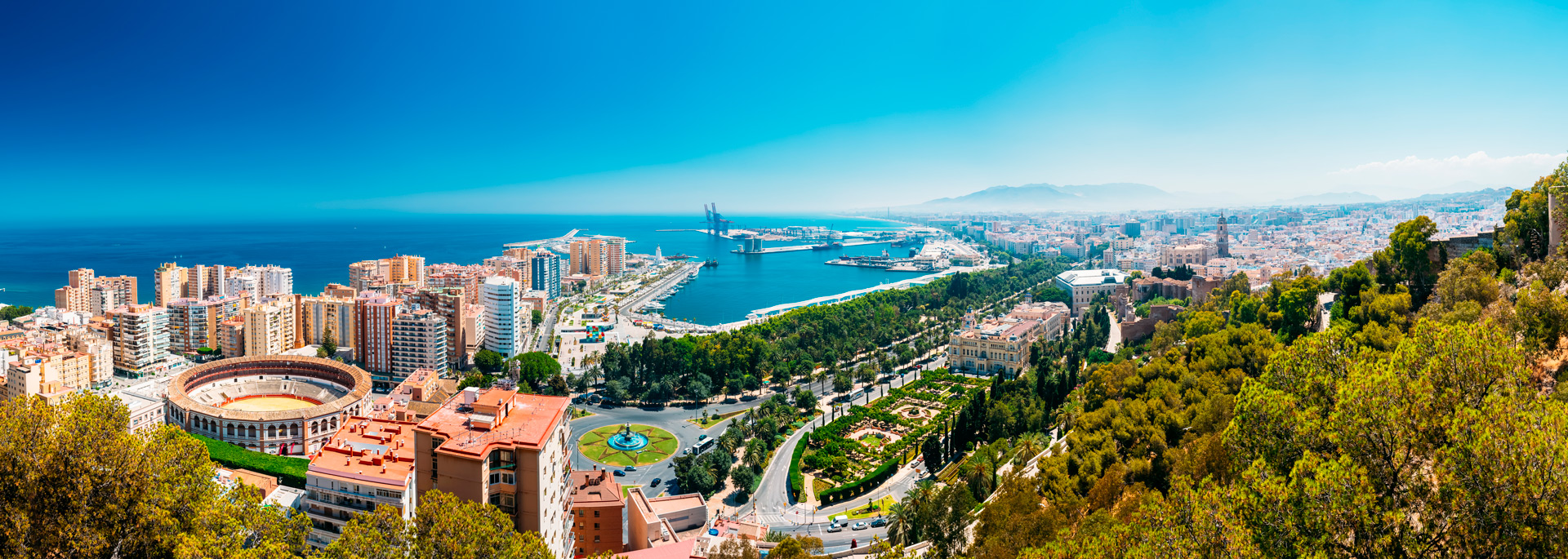

Capital of “Costa del Sol”, a beautiful mediterranean city
The city of Malaga is located in a privileged enclave. The municipality extends over an area of 398.25 square kilometres and its “de facto” urban population reaches the million inhabitants mark.
The main environmental and geographical factors that have intervened in the city’s evolution and development have been maritime influences, its location in two river valleys (the Guadalhorce and the Guadalmina), its relief and its climate.
GEOGRAPHICAL DATA
Province
Surface area: 7,276 Sqkm.
Population: 1.641.098 inhabitants (2012)
Municipality of Malaga
Surface Area: 398.25 SqKm.
Population: 567.433 inhabitants (2012)
Whilst the Mediterranean Sea bathes the Malaga coastline, the Malaga Mountains close ranks behind to form a barrier of peaks that protects the city from the cold, whilst the regulating effect of the sea ensures the area its characteristic mild temperatures. The hottest months are July and August and the coldest are usually December and February, when the average temperatures vary between a maximum of 22.8ºC and a minimum of 13ºC. Rainfall in Malaga follows the seasons, with the most abundant rains occurring in autumn and winter.
At the mouth of the River Guadalhorce, river sediments have formed the area known as the “Guadalhorce Mudflats”. Declared a Protected Natural Space in 1989, they currently occupy an area of 60 hectares. The other river that has played a decisive role in the history of Malaga is the Guadalmedina, which in Arabic means “the river of the city”. It is 47 kilometres long and is fed mostly by the waters that run down from the Malaga Mountains.
The Malaga Mountains were declared a National Park in 1989. This gave greater protection to an area of 4,762 hectares, of which 97% is located within the municipality of Malaga. Its relief is steep and rugged, with summits that reach an average altitude of 500 metres. Its tree cover originates from the hydrological-forestry reforestations carried from the end of the 30s and the area contains over 230 different varieties of vegetation and more than 160 species of vertebrates.
Subscribe to the monthly newsletter to receive the latest news.

Nam porttitor blandit accumsan. Ut vel dictum sem, a pretium dui. In malesuada enim in dolor euismod
Nam porttitor blandit accumsan. Ut vel dictum sem, a pretium dui. In malesuada enim in dolor euismod

Nam porttitor blandit accumsan. Ut vel dictum sem, a pretium dui. In malesuada enim in dolor euismod

Nam porttitor blandit accumsan. Ut vel dictum sem, a pretium dui. In malesuada enim in dolor euismod
Nam porttitor blandit accumsan. Ut vel dictum sem, a pretium dui. In malesuada enim in dolor euismod

Nam porttitor blandit accumsan. Ut vel dictum sem, a pretium dui. In malesuada enim in dolor euismod

Nam porttitor blandit accumsan. Ut vel dictum sem, a pretium dui. In malesuada enim in dolor euismod
Nam porttitor blandit accumsan. Ut vel dictum sem, a pretium dui. In malesuada enim in dolor euismod

Nam porttitor blandit accumsan. Ut vel dictum sem, a pretium dui. In malesuada enim in dolor euismod

Nam porttitor blandit accumsan. Ut vel dictum sem, a pretium dui. In malesuada enim in dolor euismod
Nam porttitor blandit accumsan. Ut vel dictum sem, a pretium dui. In malesuada enim in dolor euismod

Nam porttitor blandit accumsan. Ut vel dictum sem, a pretium dui. In malesuada enim in dolor euismod
Necessary cookies are absolutely essential for the website to function properly. These cookies ensure basic functionalities and security features of the website, anonymously.
| Cookie | Duration | Description |
|---|---|---|
| cookielawinfo-checbox-analytics | 11 months | This cookie is set by GDPR Cookie Consent plugin. The cookie is used to store the user consent for the cookies in the category "Analytics". |
| cookielawinfo-checbox-functional | 11 months | The cookie is set by GDPR cookie consent to record the user consent for the cookies in the category "Functional". |
| cookielawinfo-checbox-others | 11 months | This cookie is set by GDPR Cookie Consent plugin. The cookie is used to store the user consent for the cookies in the category "Other. |
| cookielawinfo-checkbox-necessary | 11 months | This cookie is set by GDPR Cookie Consent plugin. The cookies is used to store the user consent for the cookies in the category "Necessary". |
| cookielawinfo-checkbox-performance | 11 months | This cookie is set by GDPR Cookie Consent plugin. The cookie is used to store the user consent for the cookies in the category "Performance". |
| viewed_cookie_policy | 11 months | The cookie is set by the GDPR Cookie Consent plugin and is used to store whether or not user has consented to the use of cookies. It does not store any personal data. |
Functional cookies help to perform certain functionalities like sharing the content of the website on social media platforms, collect feedbacks, and other third-party features.
Performance cookies are used to understand and analyze the key performance indexes of the website which helps in delivering a better user experience for the visitors.
Analytical cookies are used to understand how visitors interact with the website. These cookies help provide information on metrics the number of visitors, bounce rate, traffic source, etc.
Advertisement cookies are used to provide visitors with relevant ads and marketing campaigns. These cookies track visitors across websites and collect information to provide customized ads.
Other uncategorized cookies are those that are being analyzed and have not been classified into a category as yet.